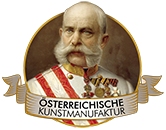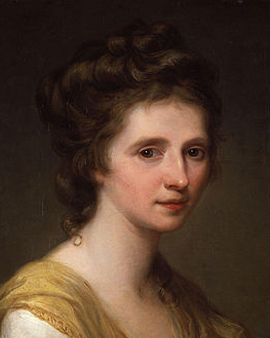Maria Anna Angelica Catharina Kauffmann, better known as Angelika Kauffmann, was born in Chur, in Switzerland. Her father Johann Kauffmann was a portrait and fresco painter, and the family soon moved to Como, where the father's most important clients, who would later become hers, were located. The girl was considered a child prodigy at an early age, receiving lessons in painting, music and languages. At 12 she painted her first self-portrait, all in all she spent a childhood surrounded by wealth and splendor.
After the death of her mother, she lived with her father in Vorarlberg, where the two were commissioned to redesign it after a church fire. Following the example of the Italian artist Giovanni Battista Piazzetta she painted apostle figures, this was to remain her only murals. On commissioned trips she made portraits of bishops, counts and ordinary citizens, so she financed her studies of ancient and Renaissance art in Italy. In Florence she received a diploma from the Accademia del disegno (Eng. Academy of Drawing). She became famous for her portrait of Johann Winckelmann, founder of scientific archaeology and art history. She painted portraits of other celebrities, including those of the actor David Garrick and the most influential English painter of the 18th century, Sir Joshua Reynolds. In 1767 she fell for a marriage swindler who made off with all her possessions - the marriage was later declared invalid. Kauffmann was one of the few women appointed by the king as founding members of the Royal Academy. Her father married her to the Italian classicist painter Antonio Zucchi, who also became her patron and with whom she moved to Rome. There she was in the company of artists, crown princes, aristocrats and even met Johann Wolfgang von Goethe, for whose "Iphigenia" she made illustrations. In 1792 she painted her most famous work "Self-portrait at the crossroads between music and painting", after which she gave herself mainly to religious themes.
She died in Rome, a bust of her was erected in the Pantheon in her honor. The Italian sculptor and most admired artist of classicism, Antonio Canova, organized a pompous funeral procession for her death, years later biographies appeared. This was followed by a portrait of her on the hundred shilling bill, a stamp of one of her paintings in Liechtenstein, and the Angelika Kauffmann Museum was established in her adopted home in Vorarlberg. Kauffmann will always retain an important position in the art world for her portraits and history paintings in the Rococo and Classicist styles and for her prominent role as a woman in art in a male-dominated world.
×





_-_(MeisterDrucke-255322).jpg)
_-_(MeisterDrucke-255322).jpg)
.jpg)
.jpg)
.jpg)
.jpg)
.jpg)
.jpg)
.jpg)
.jpg)
.jpg)
.jpg)
 - (MeisterDrucke-284781).jpg)
 - (MeisterDrucke-284781).jpg)
_-_(MeisterDrucke-84775).jpg)
_-_(MeisterDrucke-84775).jpg)
_-_(MeisterDrucke-906109).jpg)
_-_(MeisterDrucke-906109).jpg)
.jpg)
.jpg)
.jpg)
.jpg)
_-_Ch_-_(MeisterDrucke-1028553).jpg)
_-_Ch_-_(MeisterDrucke-1028553).jpg)
.jpg)
.jpg)
.jpg)
.jpg)
_-_(MeisterDrucke-1117435).jpg)
_-_(MeisterDrucke-1117435).jpg)
.jpg)
.jpg)
.jpg)
.jpg)
.jpg)
.jpg)
.jpg)
.jpg)
.jpg)
.jpg)
.jpg)
.jpg)
_German_archae_-_(MeisterDrucke-1103628).jpg)
_German_archae_-_(MeisterDrucke-1103628).jpg)
.jpg)
.jpg)
.jpg)
.jpg)
.jpg)
.jpg)
.jpg)
.jpg)
 as a Muse - (MeisterDrucke-791).jpg)
 as a Muse - (MeisterDrucke-791).jpg)
.jpg)
.jpg)
.jpg)
.jpg)
.jpg)
.jpg)
.jpg)
.jpg)
.jpg)
.jpg)
_-_(MeisterDrucke-1384072).jpg)
_-_(MeisterDrucke-1384072).jpg)
.jpg)
.jpg)
.jpg)
.jpg)
_18th_century_-_(MeisterDrucke-960585).jpg)
_18th_century_-_(MeisterDrucke-960585).jpg)
 - (MeisterDrucke-102412).jpg)
 - (MeisterDrucke-102412).jpg)
.jpg)
.jpg)
.jpg)
.jpg)
.jpg)
.jpg)
.jpg)
.jpg)
_-_(MeisterDrucke-1112586).jpg)
_-_(MeisterDrucke-1112586).jpg)
.jpg)
.jpg)
.jpg)
.jpg)
.jpg)
.jpg)
.jpg)
.jpg)
_-_(MeisterDrucke-1434517).jpg)
_-_(MeisterDrucke-1434517).jpg)
_-_(MeisterDrucke-1130754).jpg)
_-_(MeisterDrucke-1130754).jpg)
.jpg)
.jpg)
.jpg)
.jpg)
.jpg)
.jpg)
.jpg)
.jpg)
.jpg)
.jpg)
.jpg)
.jpg)
.jpg)
.jpg)
.jpg)
.jpg)
.jpg)
.jpg)
.jpg)
.jpg)
.jpg)
.jpg)
.jpg)
.jpg)
.jpg)
.jpg)
.jpg)
.jpg)
.jpg)
.jpg)
.jpg)
.jpg)
.jpg)
.jpg)
.jpg)
.jpg)
.jpg)
.jpg)
.jpg)
.jpg)
_-_P_-_(MeisterDrucke-1325275).jpg)
_-_P_-_(MeisterDrucke-1325275).jpg)
.jpg)
.jpg)
.jpg)
.jpg)
.jpg)
.jpg)
.jpg)
.jpg)
 King of Naples and his Family - (MeisterDrucke-60396).jpg)
 King of Naples and his Family - (MeisterDrucke-60396).jpg)
.jpg)
.jpg)
.jpg)
.jpg)
_-_(MeisterDrucke-1132464).jpg)
_-_(MeisterDrucke-1132464).jpg)
.jpg)
.jpg)
_Peinture_dAngelika_Kauffmann_(1741-1807_-_(MeisterDrucke-1014710).jpg)
_Peinture_dAngelika_Kauffmann_(1741-1807_-_(MeisterDrucke-1014710).jpg)
.jpg)
.jpg)
.jpg)
.jpg)
.jpg)
.jpg)
.jpg)
.jpg)
.jpg)
.jpg)
_-_(MeisterDrucke-1091228).jpg)
_-_(MeisterDrucke-1091228).jpg)
.jpg)
.jpg)
.jpg)
.jpg)
.jpg)
.jpg)
.jpg)
.jpg)
_-_(MeisterDrucke-222256).jpg)
_-_(MeisterDrucke-222256).jpg)
.jpg)
.jpg)
.jpg)
.jpg)
.jpg)
.jpg)
.jpg)
.jpg)
 engraved by Luigi Schiavonetti (1765-1810) - (MeisterDrucke-90988).jpg)
 engraved by Luigi Schiavonetti (1765-1810) - (MeisterDrucke-90988).jpg)
.jpg)
.jpg)
.jpg)
.jpg)
.jpg)
.jpg)
.jpg)
.jpg)
.jpg)
.jpg)






